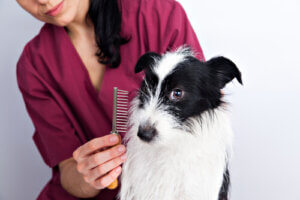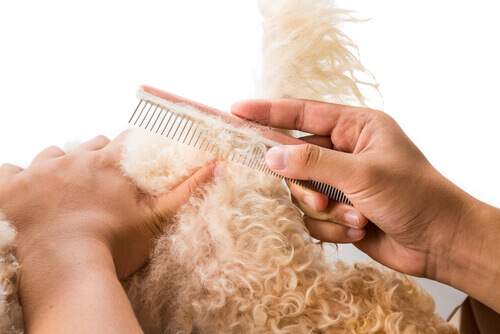A Few Tips for Grooming a Dog's Coat


Written and verified by the biologist Natalia Laguna
Trips to the dog groomer aren’t always pleasant for a pet and that’s a well-known fact. This is because no dog likes to stand still and be handled by a stranger. However, grooming a dog’s coat is necessary and this isn’t only for aesthetic reasons; it’s also a matter of health.
Generally, our pets cohabit with us in areas such as our living room and sometimes even our beds. It’s for this reason that you’ll want to keep them clean and free of dirt.
Grooming a dog’s coat is important as it serves essential functions
However, the care of a dog’s coat isn’t only about aesthetics and cleanliness. In general, hair is an important part of a dog.
Each breed physiologically and morphologically adapted to the area they came from. A dog’s coat is one of the most important adaptations to their original environment.
The fur protects animals from environmental factors such as extreme temperatures or humidity. This blanket of keratinized structures creates a barrier that’s also an air chamber. Thus, it maintains the body heat during cold weather and creates a small draft for ventilation in hot temperatures.
At the same time, their hair also protects them from the sun by helping them avoid the irritation caused by skin burns. The dog’s coat also protects their skin against possible injuries that may occur during games or walks.
The brightness and quality of a dog’s coat are an indicator of the animal’s health and this varies according to their age, sex, and breed. Here are some factors to take into account when it comes to taking care of your dog’s fur.

Tips for grooming a dog’s coat
Diet
In order to have a healthy, strong, shiny coat, an animal’s skin must also be healthy. In turn, you must pay special attention to a dog’s diet to ensure that their skin is healthy.
The canine’s diet must be well-balanced and contain the proper amount of proteins, carbohydrates, and fats. These fats should include Omega 3 and Omega 6 fatty acids as well as antioxidants. This is because these substances coat the scalp and also provide the necessary shine and protection to the fur.
An animal who doesn’t eat properly will use all the nutrients in their diet for other essential functions such as cell renewal. This will result in poorer coat quality.
In the olden days, people added homemade food supplements such as eggs, fish oil, and butter. Today there are options on the market. Some of these products include all the components an animal needs to be healthy and have a balanced diet.
Bathing
This is a fundamental part of dog hygiene and keeps allergens, parasites, and bacteria away from your beloved furry friends and from their immediate environment.
Bathing your animal is a must in order to maintain a clean healthy coat. However, don’t overdo it either as this would alter the natural pH of your pet’s skin. Depending on the activity and type of coat, we recommend doing it every 3 weeks or once a month.
In addition, the choice of shampoo is an important factor. There are different products designed for specific types of fur. Your veterinarian will be available to advise you on the most suitable ones for your dog. The best one will nourish, regenerate, and strengthen the animal’s hair and skin.
It’s also highly advisable to massage them as you apply the shampoo during the bath. This is how you activate the sebaceous glands of their skin; plus, of course, they’ll love it.
You must also pay attention to how you dry them afterward. Try to do so in the direction the hair grows in. This step is important, as being wet for too long can cause discomfort in the animal.

Brushing
By periodically brushing your dog’s coat, you remove dead hair, dirt, and flaking from the skin.
Brushing also stimulates the roots and speeds up the hair change during the shedding period.
Thus, you prevent the presence of irritants that might unbalance the microbiota and facilitate subsequent colonization by germs.
As you can imagine, you’ll also prevent the appearance of external parasites such as unwanted fleas and ticks by brushing the animal. Of course, you can also apply products recommended by your veterinarian so as to avoid infestation by these parasites.
There are various types of brushes or mitts to suit every dog’s type of skin and hair. We recommend that you have a brushing session once or twice per week. As usual, it’ll vary, depending on any given animal’s type of hair.
Types of dog’s coats
Coats vary according to the breed of the dog, and thus, their care.
The main types of dog’s coats and their recommended care are:
- Short hair. Brush them 1-2 times a week and bathe them once a month or every month and a half.
- Long hair. Brush them daily and bathe them once a month
- Coarse hair. Brush them daily and bathe them 3-4 times a month
- Curly hair. Brush them daily and bathe them every 20 days or so
In addition, a more exhaustive brushing will help eliminate tangles in long-haired and curly-haired breeds.
Your pet’s hair will certainly look healthy and beautiful if you follow these tips!
Trips to the dog groomer aren’t always pleasant for a pet and that’s a well-known fact. This is because no dog likes to stand still and be handled by a stranger. However, grooming a dog’s coat is necessary and this isn’t only for aesthetic reasons; it’s also a matter of health.
Generally, our pets cohabit with us in areas such as our living room and sometimes even our beds. It’s for this reason that you’ll want to keep them clean and free of dirt.
Grooming a dog’s coat is important as it serves essential functions
However, the care of a dog’s coat isn’t only about aesthetics and cleanliness. In general, hair is an important part of a dog.
Each breed physiologically and morphologically adapted to the area they came from. A dog’s coat is one of the most important adaptations to their original environment.
The fur protects animals from environmental factors such as extreme temperatures or humidity. This blanket of keratinized structures creates a barrier that’s also an air chamber. Thus, it maintains the body heat during cold weather and creates a small draft for ventilation in hot temperatures.
At the same time, their hair also protects them from the sun by helping them avoid the irritation caused by skin burns. The dog’s coat also protects their skin against possible injuries that may occur during games or walks.
The brightness and quality of a dog’s coat are an indicator of the animal’s health and this varies according to their age, sex, and breed. Here are some factors to take into account when it comes to taking care of your dog’s fur.

Tips for grooming a dog’s coat
Diet
In order to have a healthy, strong, shiny coat, an animal’s skin must also be healthy. In turn, you must pay special attention to a dog’s diet to ensure that their skin is healthy.
The canine’s diet must be well-balanced and contain the proper amount of proteins, carbohydrates, and fats. These fats should include Omega 3 and Omega 6 fatty acids as well as antioxidants. This is because these substances coat the scalp and also provide the necessary shine and protection to the fur.
An animal who doesn’t eat properly will use all the nutrients in their diet for other essential functions such as cell renewal. This will result in poorer coat quality.
In the olden days, people added homemade food supplements such as eggs, fish oil, and butter. Today there are options on the market. Some of these products include all the components an animal needs to be healthy and have a balanced diet.
Bathing
This is a fundamental part of dog hygiene and keeps allergens, parasites, and bacteria away from your beloved furry friends and from their immediate environment.
Bathing your animal is a must in order to maintain a clean healthy coat. However, don’t overdo it either as this would alter the natural pH of your pet’s skin. Depending on the activity and type of coat, we recommend doing it every 3 weeks or once a month.
In addition, the choice of shampoo is an important factor. There are different products designed for specific types of fur. Your veterinarian will be available to advise you on the most suitable ones for your dog. The best one will nourish, regenerate, and strengthen the animal’s hair and skin.
It’s also highly advisable to massage them as you apply the shampoo during the bath. This is how you activate the sebaceous glands of their skin; plus, of course, they’ll love it.
You must also pay attention to how you dry them afterward. Try to do so in the direction the hair grows in. This step is important, as being wet for too long can cause discomfort in the animal.

Brushing
By periodically brushing your dog’s coat, you remove dead hair, dirt, and flaking from the skin.
Brushing also stimulates the roots and speeds up the hair change during the shedding period.
Thus, you prevent the presence of irritants that might unbalance the microbiota and facilitate subsequent colonization by germs.
As you can imagine, you’ll also prevent the appearance of external parasites such as unwanted fleas and ticks by brushing the animal. Of course, you can also apply products recommended by your veterinarian so as to avoid infestation by these parasites.
There are various types of brushes or mitts to suit every dog’s type of skin and hair. We recommend that you have a brushing session once or twice per week. As usual, it’ll vary, depending on any given animal’s type of hair.
Types of dog’s coats
Coats vary according to the breed of the dog, and thus, their care.
The main types of dog’s coats and their recommended care are:
- Short hair. Brush them 1-2 times a week and bathe them once a month or every month and a half.
- Long hair. Brush them daily and bathe them once a month
- Coarse hair. Brush them daily and bathe them 3-4 times a month
- Curly hair. Brush them daily and bathe them every 20 days or so
In addition, a more exhaustive brushing will help eliminate tangles in long-haired and curly-haired breeds.
Your pet’s hair will certainly look healthy and beautiful if you follow these tips!
All cited sources were thoroughly reviewed by our team to ensure their quality, reliability, currency, and validity. The bibliography of this article was considered reliable and of academic or scientific accuracy.
Piel, Dialnet. Recogido a 8 de Mayo en https://dialnet.unirioja.es/servlet/articulo?codigo=4943892
Aceite de pescado, Dialnet. Recogido a 8 de Mayo en https://dialnet.unirioja.es/servlet/articulo?codigo=6627207
This text is provided for informational purposes only and does not replace consultation with a professional. If in doubt, consult your specialist.








